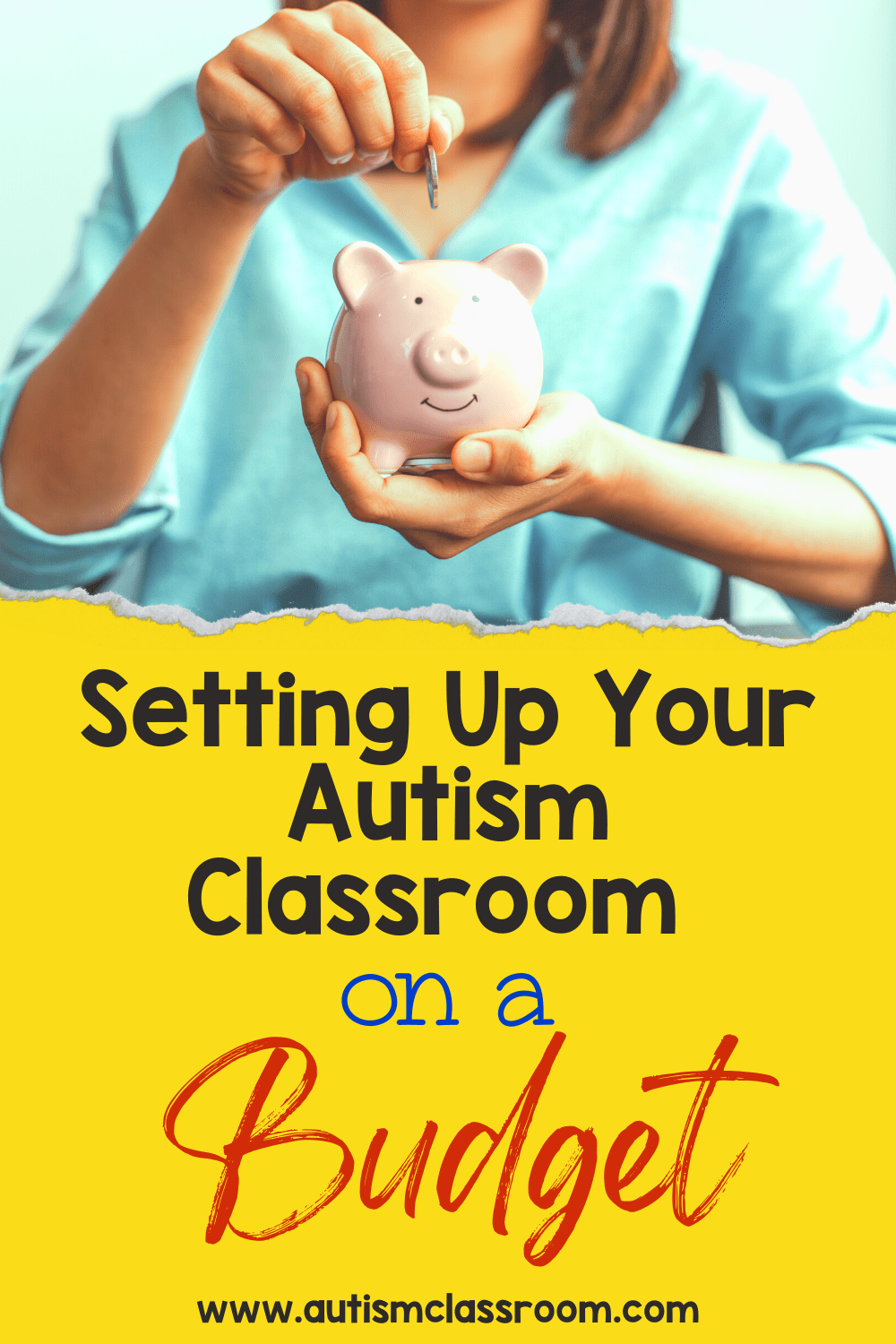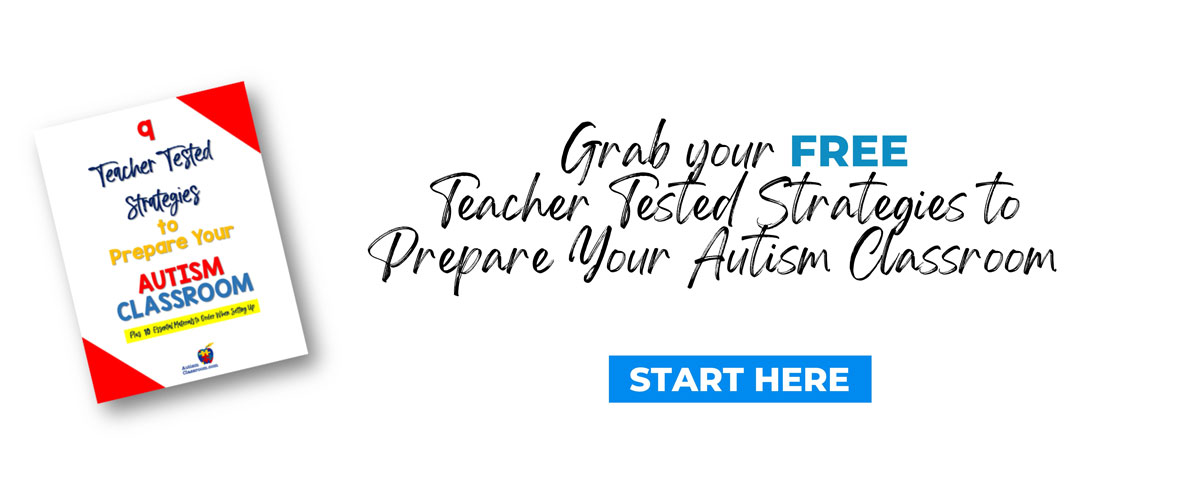Inside: Tips for Autism Support Classrooms, What to Buy, and How to Prepare an Autism Classroom
So it’s that time of year again, huh? Time to set up your autism classroom and every time you find something new to create or make, you see dollar signs. Maybe you’re a first year teacher trying to save money or a veteran teacher switching grade levels, from general education to a special education classroom set up, or maybe you’re revamping your own autism classroom. Setting up a classroom is not always cheap and setting up an autism classroom can sometimes be even more expensive. Not to mention time consuming because, of course, you want to get it right. In today’s economy, with budget cuts and school districts cutting back on expenses, this challenge is intensified. From creating communication tools to worksheets, manipulatives and games…the total cost seems to just increase. Lucky for you, I’ve been down that road and I’ve learned a few things. Take a look.
Setting up a classroom is not always cheap and setting up an autism classroom can sometimes be even more expensive. Not to mention time consuming because, of course, you want to get it right. In today’s economy, with budget cuts and school districts cutting back on expenses, this challenge is intensified. From creating communication tools to worksheets, manipulatives and games…the total cost seems to just increase. Lucky for you, I’ve been down that road and I’ve learned a few things. Take a look.
Design
There are many ways that a person can create a useful and effective autism classroom on a budget. Designing the classroom is an important element in creating the type of room that fosters community and helps students be successful. Here are some creative ways to save money on the materials and items used to design the classroom:
- When designing a room, use dollar store templates for creating name cards instead of buying expensive name cards. Or, just print out your own using a really cool font (check dafont.com for free personal use fonts). Extend their life by using clear packing tape which can be used to “laminate” items by sticking the tape to both sides of the item.
- Teachers who currently teach in a school that they will be returning to next year, can ask the administrators if they can use items from the school art closet at the end of the school year to prepare for the upcoming year. There are usually a bunch of items in the art closet that are just sitting there waiting to be used to create useful material that will assist in any special education classroom set up. For example, construction paper, 3-hole punch devices, glitter, finger paint, scissors, clip boards, permanent markers, note pads, folders, tape, poster board, staplers and other good finds are just waiting. Kindly ask the principal or secretary if it is alright to take a look in preparation for the school year.
- Index cards are another extremely useful item that are inexpensive. Around back to school time, index cards can be found very cheap - try to stock up or request them in your district supply order if you’re a returning teacher. Index cards can be used to make a number of teacher-made items such as matching games, alphabet flash cards, number cards, picture identification cards, labels for bins and more. Simply use a permanent marker and good handwriting and you have teaching materials that are also easily replaceable if damaged.
- Decorating can be cheap too. You can start by making your own bulletin board borders for your special education classroom set up by using construction paper strips and gluing on small designs created by the students. (You can even do this as part of an art lesson with your students.) Bulletin board paper can be used in other ways, too. If needed, you can use bulletin board paper as a “curtain” to cover distracting items or shelves that appear cluttered.
- If your school will not order one of those expensive carpets from a catalog or an online store, you can try putting together two or three “furry blankets” on your existing carpet to have students sit on during a quiet time or calm down time. They could from a discount store like Marshall's, TJ Maxx or Ross. You can also check thrift stores like Goodwill, Savers, Salvation Army, or Habitat for Humanity Restore for rugs.
Furniture
Hopefully your school has the necessary furniture, such as desks, tables, and some bookshelves but don’t expect much more. If you are looking to create centers or specific areas of your classroom, you will want to find creative ways to divide or section off each area. Furniture can be costly, but recycling or upcycling will be your best friend! Check with the school ahead of time to find out what furniture will be in your room.
When creating a division in the room, it is common to use heavy partitions or study carrels which can cost hundreds of dollars. To save some cash, use cardboard or corrugated dividers instead of expensive partitions. Dividers like these can be found on amazon. These dividers are light-weight and can be removed and stored away easily or can be secured by placing something such as a desk or table on both sides of them to help them stay up. You always have to be careful to have items that do not tip over easily, especially if you have a student that may like to throw or push things. Sturdy bookcases (that are safely secured) can also be used to divide up areas of the classroom and double as storage for that learning area.
Finding the right tools for any special education classroom set up can be a challenge. Make sure to set a budget, be realistic, resourceful, and never be embarrassed to ask for help. Family and friends are almost always willing to help by donating used items or helping upcycle or create. If you are still looking for ideas for setting up the classroom, get the book “How to Set Up a Classroom for Students with Autism: Third Edition” or take the Step by Step Autism Classroom Design online course based on the book, with modules, printables and videos about setting up your autism classroom from scratch. And be sure to check out Part 2 of this post Setting Up an Autism Classroom (On a Budget) Part 2.


